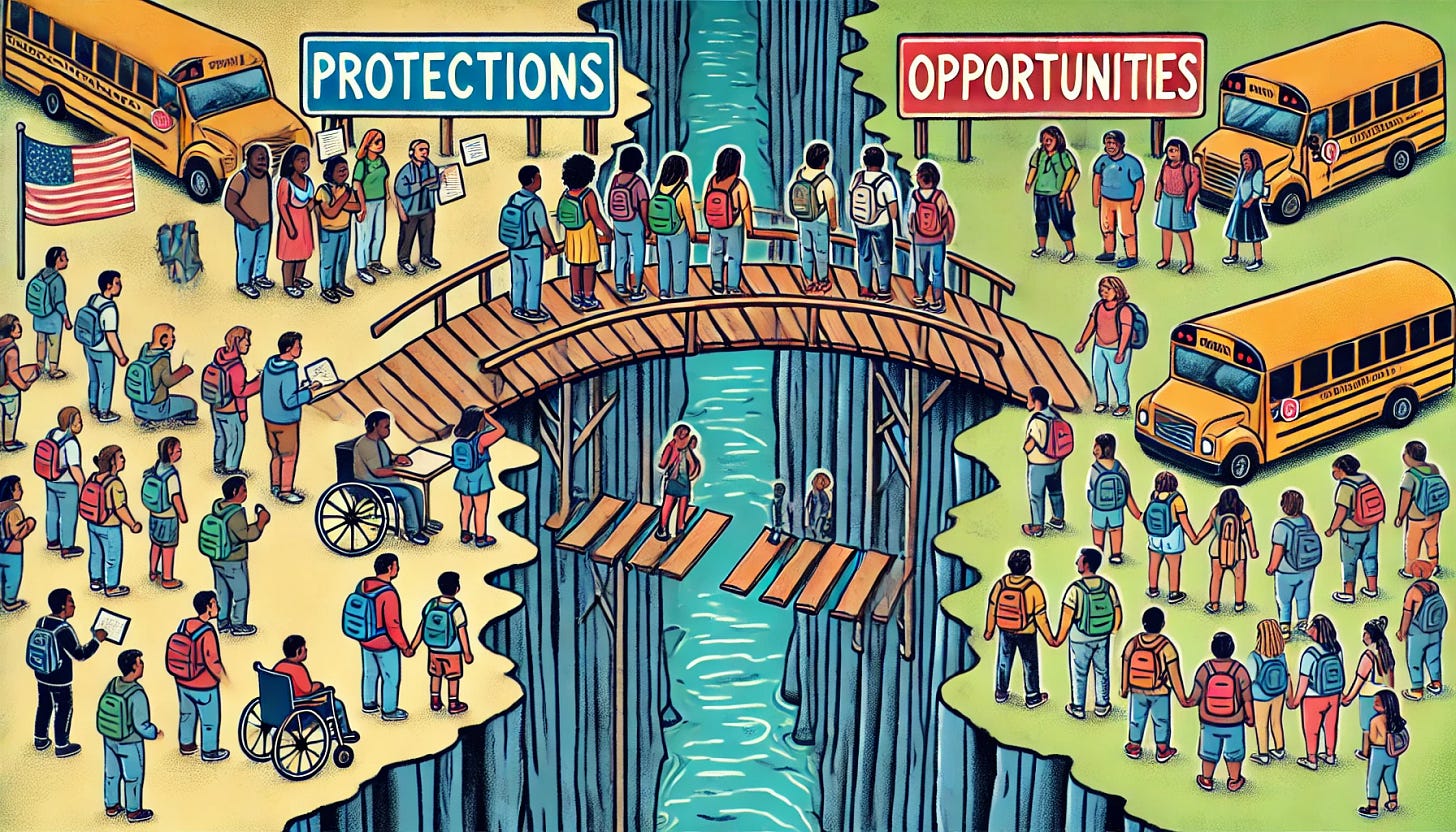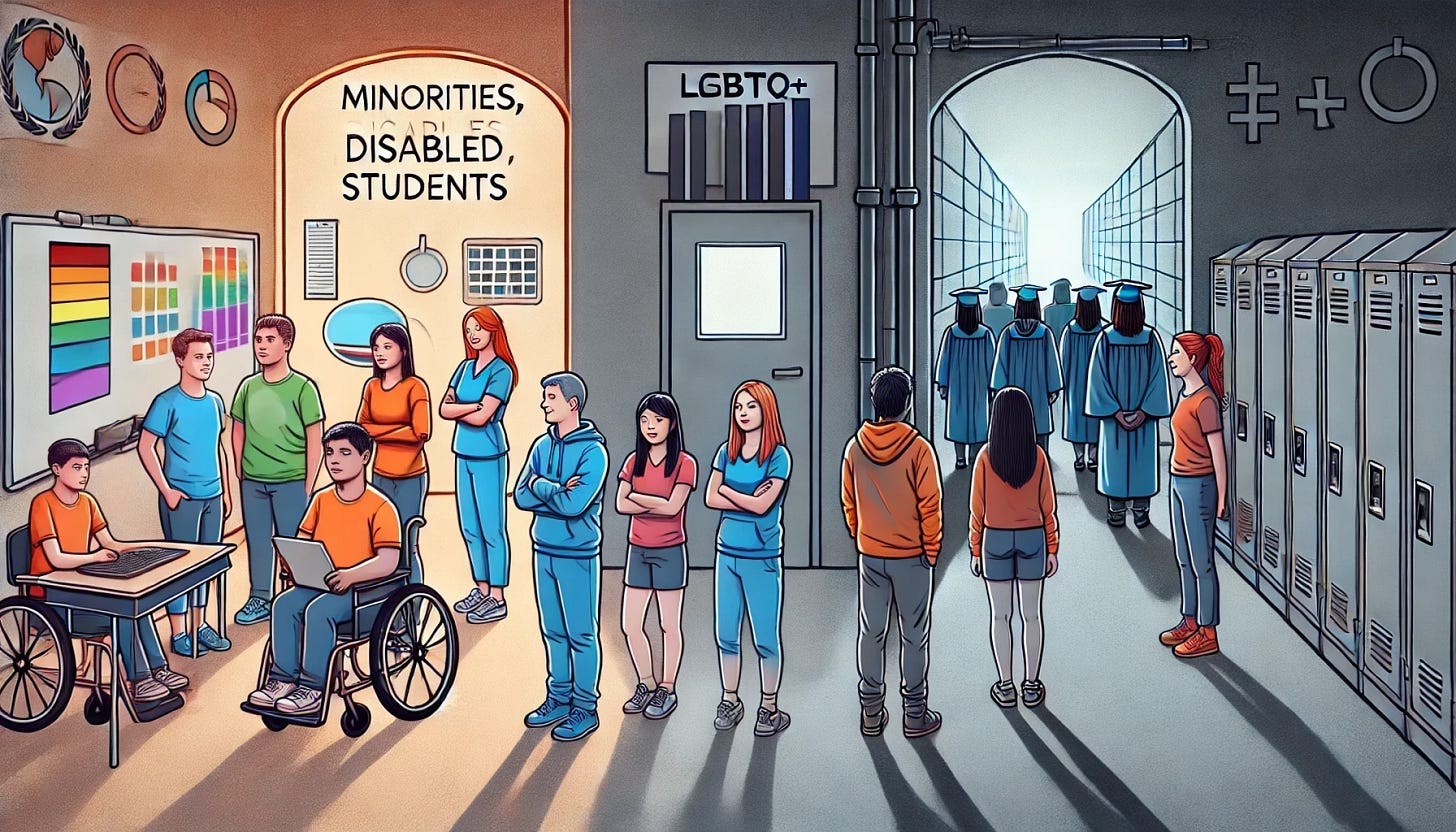In recent statements, former President Donald Trump has outlined his vision for transforming U.S. education, touching on issues that resonate deeply with K-12 teachers, families, and policymakers. His agenda pivots on three primary proposals:
Eliminating the Department of Education
Restricting so-called “woke” teachings
Implementing universal school choice
While these ideas tap into widely debated concerns about education, they also raise significant questions regarding feasibility, public support, and potential unintended consequences. This essay critically examines the implications of Trump’s proposed agenda and its likely impact on students, teachers, and the broader educational landscape.
1. Eliminating the Department of Education: A Step Backward for Equity
Trump’s proposal to eliminate the Department of Education aims to decentralize education to the states and reduce federal spending. However, this proposal disregards the Department’s fundamental purpose: to address disparities in access to quality education by enforcing national standards. Established in 1979 by President Jimmy Carter, the Department was designed to unify federal oversight and ensure equitable resource distribution, particularly for low-income and marginalized students.
Before its creation, education funding and policy were scattered across multiple agencies, leaving gaps in support for vulnerable populations. The Department’s programs, like Title I funding for low-income schools and IDEA for students with disabilities, ensure consistent protections nationwide. Eliminating the Department risks deepening inequities by leaving states to independently manage these responsibilities, often without the resources or political will to address systemic disparities.
A Tale of Two States
If the U.S. Department of Education were eliminated, the fate of federal education funding would depend on the legislative framework accompanying its dissolution. While some proposals suggest eliminating the funding entirely, others propose redistributing it to the states without federal oversight. Both scenarios would have profound implications for the educational systems in affluent states like State A and underfunded states like State B.
Scenario 1: Federal Funding is Eliminated
In the first scenario, where federal funding is cut entirely, states would lose billions of dollars in support for programs like Title I, which benefits low-income schools, and IDEA, which ensures services for students with disabilities. This loss would exacerbate the already significant disparities between wealthy and struggling states.
State A, with its strong local tax base, would likely find ways to maintain its educational systems. Wealthy districts would continue to thrive with minimal disruption, while low-income districts might experience some cuts but would still fare better than their counterparts in poorer states.
State B, however, would face a crisis. With little local revenue to offset the loss of federal funding, the state would be forced to reallocate resources to address other pressing needs, such as infrastructure or healthcare. Low-income schools would see drastic reductions in funding, leading to larger class sizes, outdated materials, and the loss of critical support programs. This would perpetuate cycles of poverty and inequality, as students in these schools fall further behind their peers.
Scenario 2: Federal Funding is Redistributed to States
In the second scenario, where federal funds are redistributed to the states without oversight, the disparities between State A and State B could grow even more complex. While funding would still be available, states would have complete discretion over how to use it, leading to significant variations in resource allocation and priorities.
State A, with its strong economy and well-funded education system, would be able to absorb the redistributed funds relatively easily. However, without federal guidelines mandating that these funds be used to support low-income students, State A might shift priorities. Wealthier districts could benefit disproportionately, receiving additional resources to enhance already-robust programs. Meanwhile, low-income schools in State A might still receive some funding, but without federal enforcement, the focus on equity could weaken, leaving vulnerable students with fewer targeted interventions.
State B, on the other hand, would face a starkly different reality. Reliant on federal funding to support its low-income schools, the state would now have full control over how to allocate these resources. However, economic pressures and competing priorities might lead State B to divert these funds to other areas, such as healthcare or infrastructure. Low-income schools, previously supported by federal programs, could see drastic reductions in funding, resulting in overcrowded classrooms, fewer qualified teachers, and the elimination of critical support services. Even wealthier districts in State B might struggle to maintain current standards, as the state's limited resources are spread too thin.
The Growing Divide
Over time, the disparities between State A and State B would widen. In State A, even low-income students would continue to benefit from relatively well-funded schools, albeit with fewer equity-focused interventions. The state’s wealth would allow it to maintain a baseline of quality that ensures students are not left behind.
In contrast, State B would see its educational system unravel. Low-income schools would face declining quality, limiting students’ academic performance and future opportunities. Families in State B who can afford it might relocate to better-funded states or enroll their children in private schools, further isolating low-income communities and concentrating poverty in certain districts. The cycle of inequality would deepen, leaving students in State B at a significant disadvantage compared to their peers in wealthier states.
Federal oversight, through programs like Title I, was designed to prevent inequities. Without it, geography could once again dictate the quality of a child’s education.
2. Threats to Protections for Vulnerable Students
Eliminating federal oversight would jeopardize programs that protect minority, disabled, and LGBTQ+ students, creating a fragmented system where rights depend on local policies. States could dismantle or reduce programs addressing systemic discrimination, leaving marginalized students without the necessary protections.
- For minority students, federal oversight ensures accountability for reducing racial disparities in school discipline and increasing access to advanced coursework. Without it, states with histories of systemic racism could deprioritize these efforts, worsening inequities.
- For students with disabilities, IDEA1 mandates essential accommodations, such as individualized education plans (IEPs). States without federal oversight may lack the resources or commitment to provide these services, resulting in reduced educational quality for disabled students.
- For LGBTQ+ students, Title IX ensures protections against discrimination based on gender identity and sexual orientation. Federal enforcement has clarified these rights, but without it, some states may implement restrictive policies, fostering hostile environments and harming students’ mental health and academic performance.
3. Universal School Choice: Widening the Resource Gap
Trump’s proposal for universal school choice includes federal tax credits for private school tuition and homeschooling. Advocates claim this would empower parents, but critics warn it could undermine public schools by redirecting resources to private institutions, exacerbating disparities.
The same accountability standards do not bind private schools to public schools, and tax credits primarily benefit families who can already afford private education. Meanwhile, public schools, particularly in low-income areas, could lose critical funding, deepening existing inequities. Historical resistance to similar initiatives and voter rejections of school-choice measures highlight the challenges of implementing such policies at scale.
Why Federal Oversight Matters
The Department of Education was established to address systemic inequities in education, ensuring all students—regardless of race, income, or location—have access to quality schooling. Its programs, such as Title I and IDEA, provide vital resources and enforce civil rights protections that states often fail to guarantee.
Before federal intervention, education systems were plagued by significant disparities, with marginalized groups frequently excluded from opportunities. Federal oversight remains essential for addressing these inequities and ensuring a consistent baseline of quality and fairness nationwide.
Trump’s education agenda seeks to decentralize control and reduce federal involvement, but this approach risks reversing decades of progress in educational equity. The Department of Education was created to protect vulnerable students and provide consistent standards nationwide. Eliminating it could lead to fragmented policies, widening disparities, and leaving millions of students without the support they need to thrive.
To safeguard equity and quality, educational reform should balance local control with federal oversight. The Department of Education remains a critical institution for managing resources, upholding civil rights, and ensuring that every child in America has an equal opportunity to succeed. As debates over education policy continue, it is vital to remember the lessons of history and the importance of a unified approach to equity and justice in education.
The term "IDEA" is an acronym for the Individuals with Disabilities Education Act. This is a U.S. federal law enacted in 1975, originally known as the Education for All Handicapped Children Act, and later renamed in 1990. IDEA ensures that children with disabilities receive a Free, Appropriate Public Education (FAPE) tailored to their needs.









